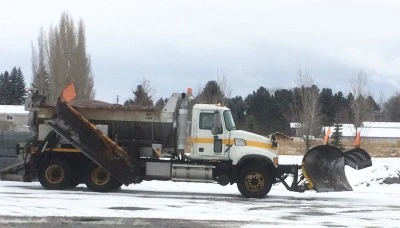
Snowplow Operations
The snow is flying here in the intermountain west and across the country. Snowplows are a familiar sight during the winter months. In areas with heavy snowfall, driving a snowplow can be a lucrative job in the winter. Most operators drive company trucks, but some people hook plows to their own personal vehicles to transform them into snowplows. However, even with personal snowplow operation, there are certain standards that the operator must follow.
Requirements for Snowplow Drivers
Many states require snowplow operators to be commercially licensed. A commercial license shows you know how to safely and efficiently operate a snowplowing vehicle. Because work conditions can be so hazardous in the winter, having a commercial license is extremely important.
Additionally, all vehicles being used as snowplows, whether company-owned or personal, must have commercial plates. In many states, you can either purchase year-round plates, or you can get special Snow Removal Plates. The latter option is specifically for the winter months. The former would allow commercial operation of the vehicle at any time during the year.
Lastly, when operating any vehicle as part of a commercial enterprise, it is required to be commercially insured. If working for a company, they will have purchased this insurance already for their vehicles. But even personal snowplow vehicles need to be commercially insured, so don’t forget this step!
What OSHA Says
In addition to the commercial requirements for snowplow driving, there are certain OSHA Requirements that must be followed. Regarding heavy equipment operations, OSHA says:
“Heavy machinery, equipment, or parts thereof, which are suspended or held aloft by use of slings, hoists, or jacks shall be substantially blocked or cribbed to prevent falling or shifting before employees are permitted to work under or between them.” (CFR 1926.600)
Even personal vehicles with attached scraper blades must follow the standards set in place by OSHA. Familiarizing yourself with the applicable standards for heavy equipment can keep you safe during operations.
How to Practice Snowplow Operation
Before you plow the first time for your company or client, you’re going to need some practice. The following are ways you can practice plowing:
- Practice operating in a large area without snow
- Familiarize yourself with the in-cab controls
- Practice driving with the blade lowered in plowing position
After you’ve had ample time to practice and you feel comfortable driving a plow, it’s time to put that practice to use. It’s important to also be familiar with OSHA’s standards.
Plowing Techniques
There are several techniques that snowplow drivers use while they operate. These techniques can make snowplowing easier and more efficient. The common plowing techniques we’ll cover include the “power V” technique, the scoop and straight positions, and the back-drag.
The “power V’ technique is done by adjusting the plow blades into a “V” position, pointing away from the truck. This is often used to make the first pass in a snowy parking lot or on a long driveway.
The different blade positions will help you move the snow in different ways. Use the scoop position by creating a “V” with the blades and pointing it towards the truck. This will collect the snow in front instead of pushing it to the sides. The straight position is achieved by angling the blade parallel with the truck’s front. This will allow the operator to push large amounts of snow into piles.
Lastly, the back-drag technique can be especially handy when plowing snow piled up against a building or other structure. Drive toward the snow with the blade in the raised position until the blade is positioned over the snow. Drop the blade and reverse, dragging the snow out with you.
For additional information about snowplow safety, check out our training (it’s on sale!). For other trainings, visit our homepage.
Good luck and stay safe!
